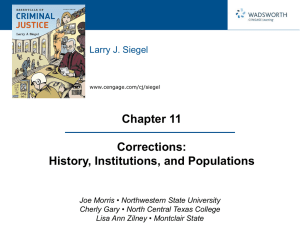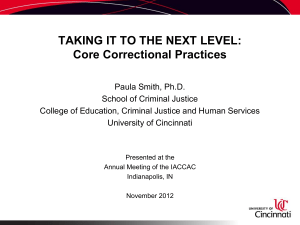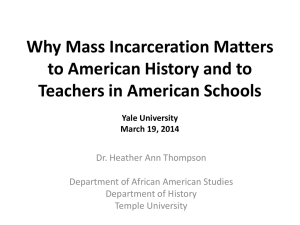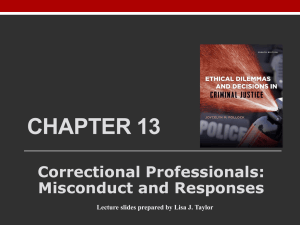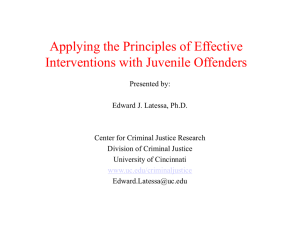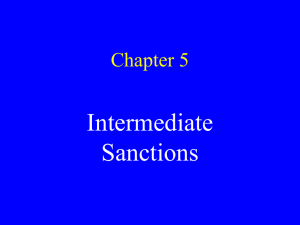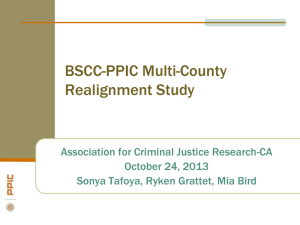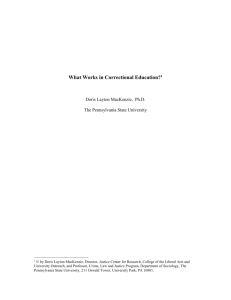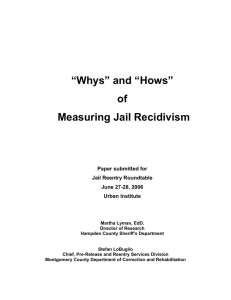Diversion and Reentry from Corrections
advertisement
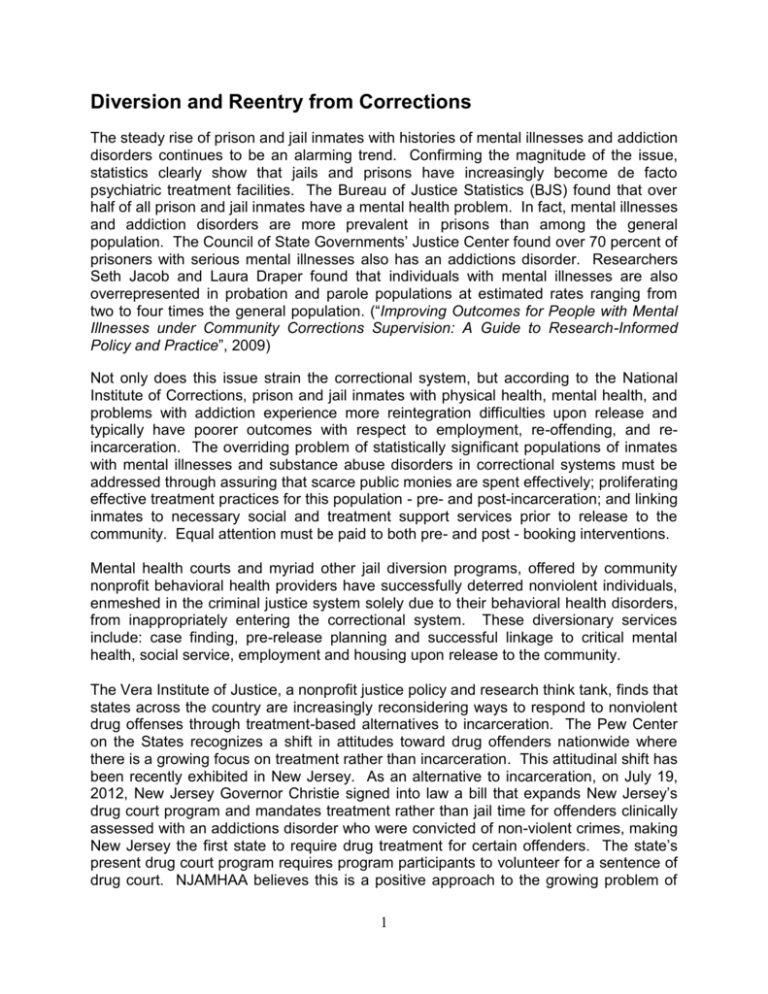
Diversion and Reentry from Corrections The steady rise of prison and jail inmates with histories of mental illnesses and addiction disorders continues to be an alarming trend. Confirming the magnitude of the issue, statistics clearly show that jails and prisons have increasingly become de facto psychiatric treatment facilities. The Bureau of Justice Statistics (BJS) found that over half of all prison and jail inmates have a mental health problem. In fact, mental illnesses and addiction disorders are more prevalent in prisons than among the general population. The Council of State Governments’ Justice Center found over 70 percent of prisoners with serious mental illnesses also has an addictions disorder. Researchers Seth Jacob and Laura Draper found that individuals with mental illnesses are also overrepresented in probation and parole populations at estimated rates ranging from two to four times the general population. (“Improving Outcomes for People with Mental Illnesses under Community Corrections Supervision: A Guide to Research-Informed Policy and Practice”, 2009) Not only does this issue strain the correctional system, but according to the National Institute of Corrections, prison and jail inmates with physical health, mental health, and problems with addiction experience more reintegration difficulties upon release and typically have poorer outcomes with respect to employment, re-offending, and reincarceration. The overriding problem of statistically significant populations of inmates with mental illnesses and substance abuse disorders in correctional systems must be addressed through assuring that scarce public monies are spent effectively; proliferating effective treatment practices for this population - pre- and post-incarceration; and linking inmates to necessary social and treatment support services prior to release to the community. Equal attention must be paid to both pre- and post - booking interventions. Mental health courts and myriad other jail diversion programs, offered by community nonprofit behavioral health providers have successfully deterred nonviolent individuals, enmeshed in the criminal justice system solely due to their behavioral health disorders, from inappropriately entering the correctional system. These diversionary services include: case finding, pre-release planning and successful linkage to critical mental health, social service, employment and housing upon release to the community. The Vera Institute of Justice, a nonprofit justice policy and research think tank, finds that states across the country are increasingly reconsidering ways to respond to nonviolent drug offenses through treatment-based alternatives to incarceration. The Pew Center on the States recognizes a shift in attitudes toward drug offenders nationwide where there is a growing focus on treatment rather than incarceration. This attitudinal shift has been recently exhibited in New Jersey. As an alternative to incarceration, on July 19, 2012, New Jersey Governor Christie signed into law a bill that expands New Jersey’s drug court program and mandates treatment rather than jail time for offenders clinically assessed with an addictions disorder who were convicted of non-violent crimes, making New Jersey the first state to require drug treatment for certain offenders. The state’s present drug court program requires program participants to volunteer for a sentence of drug court. NJAMHAA believes this is a positive approach to the growing problem of 1 nonviolent substance abusers ending up in the correctional system as opposed to receiving treatment in the community. Anyone entering treatment is ultimately going to have a huge statistical probability of improving. The current voluntary drug court program has shown a significant reduction in recidivism rates of its graduates. The rate at which drug court graduates are re-arrested for a new indictable offense is 16% and the reconviction rate is 8%. This is compared to re-arrest rates for drug offenders released from prison that stand at 54% with a reconviction rate of 43%, according to the Judiciary’s October 2010 Drug Court Report. According to the governor, the cost to house an inmate in state prison averages $49,000 a year, while inpatient treatment for a non-violent drug offender costs half that amount. Such a substantial reduction in recidivism rates, as well as transfers from prison to the drug program, translates into substantial cost savings - underscoring that the program is not only about saving lives, but also about saving money. NJAMHAA concurs that it is imperative that savings realized from decreased incarcerations be reinvested in the drug program. But most importantly, the true value of community treatment is the long term benefits that directly result from reducing recidivism rates and the positive contributions to society resulting from the interventions and supports afforded by community providers. Although a national study found that voluntary drug court programs lowered recidivism rates and returned $2.21 for every dollar invested, the Pew Center on the States points out that the mandatory requirement is yet untested. NJAMHAA remains optimistic that savings will occur and, more importantly, that treatment will result in rehabilitation. Diversion programs do work. As cited in the CASA report, “Behind Bars II”, offenders who receive a continuum of evidence-based services demonstrate significantly reduced relapse and recidivism. Similarly, the National Institute of Mental Health (NIMH) found that jail diversion programs for individuals with behavioral health disorders reduce the time they spend incarcerated without increasing the risk to public safety. In light of these and similar findings, NJAMHAA strongly supports sufficiently funded innovative and evidence-based alternatives to incarceration for nonviolent offenders who have mental illnesses, addictions, and/or co-occurring mental health disorders. When persons with mental illnesses and addictions are incarcerated, they are unable to maintain vital components of recovery, such as medication regimens, housing, a job and the ability to effectively parent. NJAMHAA believes unnecessary and costly incarcerations of nonviolent offenders with behavioral health disorders must be avoided in favor of the expansion of restorative treatment programs that aid, rather than punish, individuals encountering police involvement at times of behavioral health crises. NJAMHAA Supports Mandatory treatment, through the Drug Court expansion, to be rendered only by organizations that have both licensure from the Division of Mental Health and Addiction Services (DMHAS) and oversight by the Department of Human Services (DHS) to maximize successful outcomes and minimize recidivism to the 2 greatest extent possible. Utilizing licensed providers will assure program quality and integrity and guarantee that evidence-based practices will be utilized. Increased capital funding to help providers expand to meet the increased demand on placements into treatment. If there is not sufficient expansion to meet the new demand, it could potentially result in “bumping” another person who is willingly seeking treatment and not criminal justice involved. The use of jail diversion alternatives that avoid the criminalization and the imposition of lengthy prison sentences for nonviolent persons with behavioral health issues. Expansion of the capacity of the network of nonprofit behavioral health justiceinvolved programs. These include pre- and post- booking and reentry programs. Strong linkages to medically necessary health care, medication, social, and behavioral health services prior to release from jails and prisons. Coordinated pre-release discharge planning processes are essential, including referrals to public support services, to ensure treatment for health and behavioral health issues. Continued funding of New Jersey’s Crisis Intervention Response Network, which trains active and retired police, fire and rescue personnel to act as trained peer support counselors and serves to divert those with behavioral health issues away from correctional facilities and toward community-based services. Integration of all services across the correctional, court, mental health, substance abuse and social service systems to address the needs of persons with mental health and/or addiction issues who are housed in the correctional system, who face incarceration, or who are about to be released from correctional facilities. Sufficient state and local funding of community-based nonprofits that understand the challenges faced by the consumers they serve and empower them to adopt healthy lifestyles, pursue personal and life-enriching goals, and optimize reintegration within their community and within their families. To ensure that program quality and integrity are safeguarded, licensed drug treatment providers must be Division of Mental Health and Addiction Services (DMHAS) licensed assuring that evidence-based practices are utilized and quality care is delivered, thereby maximizing successful outcomes and minimizing recidivism to the extent possible. 3
